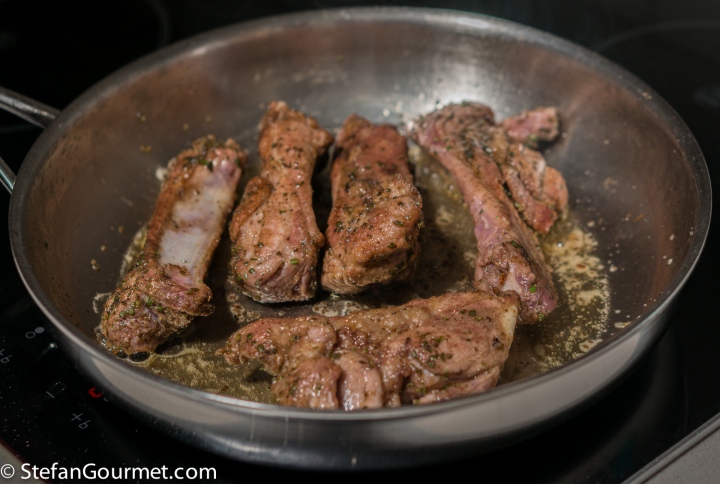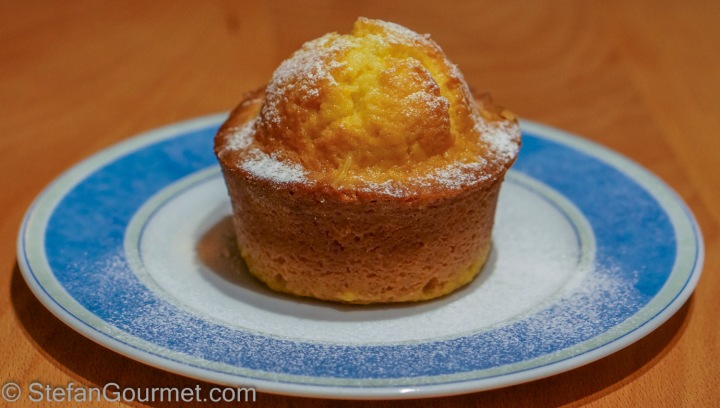This is one of those rare cases when the name of a dish sounds better in English than it does in the original Italian. Simona of Grembiule da Cucina always has wonderful Italian home cooking recipes from her region Emilia, the land of prosciutto di Parma, aceto balsamico, Parmigiano Reggiano, and Lambrusco. She wrote a wonderful story about the late feminist Rina, of whom she learned how to prepare pork ribs in umido a long time ago. A vital ingredient to this recipe, as it is for many recipes from the region, is concia, salt mixed with herbs and spices such as rosemary, sage, and cloves. I’ve mentioned a similar aromatized salt from Emilia previously, but there it was called aglione and also included garlic. Other than that, the ribs are stewed with red wine (in Emilia that means Lambrusco) and the holy trinity of onion, celery, and carrot.
Simona stewed the ribs on the stovetop, which means you have to use very low heat and turn the ribs regularly to allow them to cook evenly. It won’t be a surprise that I opted to cook them sous-vide. In this case I chose to stick with the stewed texture, and so I cooked them sous-vide for 8 hours at 75C/167F. This will give the same result as an expert stew on the stovetop, but it is easier as you don’t have to watch the heat or turn the ribs while they are cooking. If you mess up the stovetop stewing, the ribs will end up dry. No such risk with the sous-vide preparation. But if you don’t have sous-vide equipment, please feel free to cook these ribs on the stovetop. If you do it well, the result will be the same. In any case, make these ribs because they are great. The sauce has a wonderful deep flavor. Simona, ti ringrazio per la ricetta!
Ingredients

For 2 servings
500 grams (1.1 lbs) of meaty pork ribs, cut into individual ribs
120 ml (1/2 cup) of red wine, preferably Lambrusco
1 carrot, minced
1 stick celery, minced
1/2 onion, minced
1 Tbsp butter
1 Tbsp olive oil
2 Tbsp flour
120 ml (1/2 cup) of pork stock
1 tsp corn starch (optional)
For the concia
1/2 tsp salt
1/8 tsp ground cinnamon
1/8 tsp ground cloves
1/8 tsp ground bay leaf (or 1 tsp minced bay leaf)
1/8 tsp ground nutmeg
1 Tbsp minced rosemary
1/2 Tbsp minced sage
Instructions
Mince the rosemary and sage very fine.
Make concia by combining 1/2 tsp salt, 1/8 tsp ground cinnamon, 1/8 tsp ground cloves, 1/8 tsp ground bay leaf (or 1 tsp minced bay leaf), 1/8 tsp ground nutmeg, 1 Tbsp minced rosemary, and 1/2 Tbsp minced sage.
If you are cooking the ribs on the stovetop, mix them with the concia and allow the concia to penetrate for a couple of hours in the refrigerator.
When cooking sous-vide, this step can be skipped because the concia will have plenty of time to penetrate the ribs during those 8 hours of soaking in the sous-vide. Put the ribs in a ziplock bag with the concia and 2 tablespoons of flour.
Close the ziplock bag and shake until the ribs are covered all over with flour and concia.
Heat a tablespoon of olive oil and a tablespoon of butter in a frying pan over medium high heat and add the ribs.
Brown the ribs on all sides, then take them out the pan and set aside. The concia will produce wonderful aromas.
Add minced carrot, onion, and celery to the frying pan.
Stir over medium heat until the vegetables are golden, about 10 minutes.
Add 120 ml (1/2 cup) red wine and 120 ml (1/2 cup) pork stock.
Bring to a boil, then turn off the heat. (If not cooking sous-vide, add the ribs at this point, and stew them over low heat until they are tender, turning them often.)
Vacuum seal the ribs with the vegetables. A regular “clamp” style vacuum sealer cannot be used for this, unless you freeze the liquids first. Instead, there are two options.
If you use a chamber vacuum sealer, allow everything to cool down to room temperature (refrigerated temperature is even better) and vacuum seal. Otherwise the mixture may start to boil because of the low pressure.
Otherwise, use a ziplock bag and the water displacement method.
Cook sous-vide at 75C/167F for 6 to 12 hours. There is a pretty long window in which the ribs will be great and you can take advantage of that. For instance by putting them in the sous-vide before you leave for work, and then finding them ready to eat upon your return.
After cooking sous-vide, put everything but the ribs in a saucepan, and use an immersion blender to puree it until completely smooth.
If you cooked the ribs on the stovetop, the evaporation during the cooking will probably have reduced the sauce sufficiently. In sous-vide cooking there is no evaporation, so we still need to thicken the sauce. You should taste the sauce to decide which options is preferable. If the sauce already has a strong flavor, use a bit of corn starch dissolved in cold water to thicken it. Otherwise, simply reduce the sauce until its thickness and flavor are to your liking.
Don’t forget to keep the ribs warm while you are finishing the sauce, by wrapping them in aluminum foil.
Serve the ribs with plenty of the wonderful sauce.
Wine pairing
Lambrusco has a bad reputation, and it is indeed hard to find good Lambrusco outside of Italy, but it certainly does exist and it is the perfect pairing for the ribs as it cuts through the grease.
Another light red such as Bardolino could work as well.
Flashback
These orange muffins are really miniaturized versions of a bundt cake, and they are absolutely divine because after baking they have been soaked in fresh orange juice.



















I have never used Lambrusco to cook with before. This will be a first.
LikeLike
It should be dry Lambrusco, which for many is a first to encounter.
LikeLike
Pensa un po’ cosa direbbe la Rina!
LikeLiked by 3 people
Spero che sarebbe orgogliosa che un’olandese ha fatto la sua ricetta 🙂
LikeLiked by 1 person
Credo proprio di si.
LikeLiked by 1 person
Fantastiche queste costolette Stefan. Hanno un aspetto delizioso.
🙂
LikeLiked by 1 person
That sauce looks mouth-watering good, Stefan!
LikeLiked by 1 person
Another very good recipe! I will make this very soon. My wife loves pork ribs. Great idea and adaptation for sous vide.
I wonder if the “stock” from making pork rillettes could be used? Hmm… I have some left over from making rillettes this week.
LikeLiked by 1 person
That stock could definitely be used. Just check the saltiness and adjust the seasoning accordingly.
LikeLike
Like the ingredients of the concia: cinnamon, cloves and nutmeg are not oft found in European meat cooking methinks ? Oddly enough they are very common in ‘stews’ 1/2 way across the world: I am learning Burmese cooking at the moment and have a number of recipes using these. Wish I could get my meat as lean as you tho’ . . . 🙂 !
LikeLiked by 1 person
Cloves are very common in the Netherlands at least. Cinnamon and nutmeg are less so.
Interesting about the meat: all our meat is lean because that is what the customers want. I prefer meat that has more ‘marbling’, but it is difficult to find because of that preference of the majority of the clientele.
LikeLiked by 1 person
oh yes . marbling is much better, more taste, more yummy, I always opt for that when I can get it, after all, if you are going to eat you may as well eat well and just eat less (if you can..)
LikeLiked by 1 person
Solo a guardarle capisci che sono ottime.
LikeLiked by 1 person
This sounds wonderful, Stefan. Love the spices used, especially the cinnamon. Personally, I’ve grown tired of ribs drenched in typical American barbecue sauce. I’ve spoken with Zia about going back to basics, preparing ribs like my family once did. Looks like another assignment for the two of us in the kitchen.
LikeLiked by 1 person
I’m looking forward to reading about (and trying) the Bartolini family recipe!
I can see your point about American barbecue sauce.
LikeLiked by 1 person
I cooked this yesterday. Definitely different from any ribs I have had before. I used chicken stock and merlot. The sauce was so tasty it did not need thickening or reducing. Thanks again.
LikeLiked by 1 person
Great to hear! Thanks for reporting back when you make one of my recipes. That is why I have the blog in the first place, so it always makes me very happy.
LikeLike
Oh Stefan, can you bring your sous vide equipment and come make me those ribs? Sadly I just missed my reason to go to the NL – which was the Van Gogh Munch exhibition, finished 27 jan i think :(, time flies so fast, I braised some meat on the stove yesterday, the fatigue of ensuring even temperatures, etc. was a nightmare, turned out really well, but still, the thought of stuffing it under sous vide and leaving is VERY tempting. That said, there is no space in my kitchen sadly, I guess I must move house 🙂
LikeLiked by 1 person
I know what you mean. I don’t really have the patience to babysit a braise so for me they often don’t turn out optimal. You should really check out an Anova. It really doesn’t take up any significant space (about the size of a large immersion blender) and you can just use a stock pot that you already own as the cooking container.
LikeLiked by 1 person
🙂 thanks for the tips – great to know I can ask you for advice on techie cook products – I will check out the anova! Thanks and have a GREAT weekend (not optimal is what i experienced, not bad, but not melt in the mouth, transport you to the next level of happiness tender, either..)
LikeLiked by 1 person